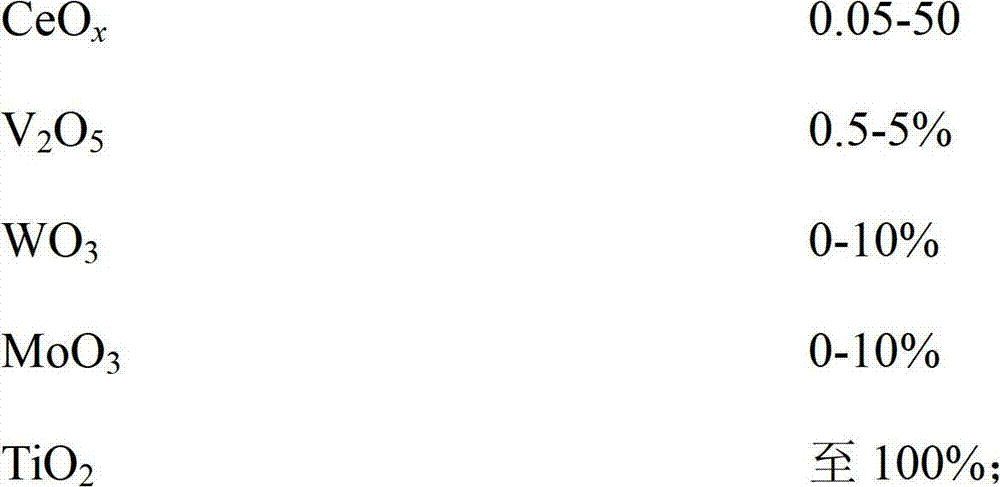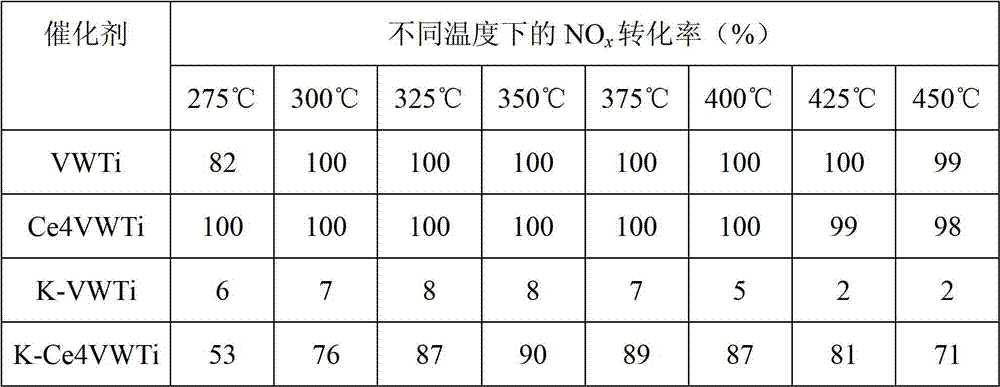Vanadium-titanium oxide catalyst, and preparation method and application thereof
A vanadium-titanium oxide and catalyst technology, which is applied in the field of cerium-doped vanadium-titanium oxide catalyst and vanadium-titanium oxide catalyst, can solve the problems of being easily affected by alkali metal poisoning
- Summary
- Abstract
- Description
- Claims
- Application Information
AI Technical Summary
Problems solved by technology
Method used
Image
Examples
Embodiment 1
[0065] Ce-doped V 2 o 5 / WO 3 -TiO 2 Catalyst, where V 2 o 5 The loading amount was 1%, and the Ce / V molar ratio was 4. After each precursor salt is dissolved into an aqueous solution and mixed uniformly, commercial titanium tungsten powder (WO 3 Content 5wt%), the solution volume to titanium tungsten powder mass ratio is 10:1 (mL / g), continuously stirred at 30°C for 2h, after rotary evaporation, put the obtained catalyst into an oven and dry at 100°C overnight, Finally, the powder catalyst was obtained by calcining in air at 500°C for 5 hours in a muffle furnace. Grind and sieve the prepared catalyst, take 40-60 mesh for later use, and call it catalyst Ce4VWTi.
Embodiment 2
[0069] The Ce4VWTi in Example 1 and the VWTi catalyst powder in Comparative Example 1 were poisoned with K element. KNO 3 Soluble in aqueous solution according to KNO 3 The solution volume and catalyst powder mass ratio were 2:1 for impregnation, and the K addition amount was K / V with a molar ratio of 4. Catalyst powder impregnated in KNO 3 After 12 hours of solution, it was dried in an oven at 100°C, and then calcined in air at 500°C for 3 hours in a muffle furnace to obtain a powdered poisoned catalyst. Grind and sieve the prepared poisoned catalysts, and take 40-60 meshes for later use, which are called catalysts K-Ce4VWTi and K-VWTi.
Embodiment 3
[0071] The Ce4VWTi in Example 1 and the VWTi catalyst powder in Comparative Example 1 were poisoned with Ca. Ca(NO 3 ) 2 4H 2 O was dissolved in the aqueous solution, impregnated according to the volume ratio of calcium nitrate solution to catalyst powder mass ratio of 2:1, and the Ca addition amount was Ca / V molar ratio of 8. The catalyst powder was soaked in calcium nitrate solution for 12 hours, dried in an oven at 100°C, and calcined in air at 500°C for 5 hours in a muffle furnace to obtain a powdered poisoned catalyst. Grind and sieve the prepared poisoned catalyst, and take 40-60 mesh for later use, called catalysts Ca-Ce4VWTi and Ca-VWTi.
PUM
 Login to View More
Login to View More Abstract
Description
Claims
Application Information
 Login to View More
Login to View More - R&D
- Intellectual Property
- Life Sciences
- Materials
- Tech Scout
- Unparalleled Data Quality
- Higher Quality Content
- 60% Fewer Hallucinations
Browse by: Latest US Patents, China's latest patents, Technical Efficacy Thesaurus, Application Domain, Technology Topic, Popular Technical Reports.
© 2025 PatSnap. All rights reserved.Legal|Privacy policy|Modern Slavery Act Transparency Statement|Sitemap|About US| Contact US: help@patsnap.com



